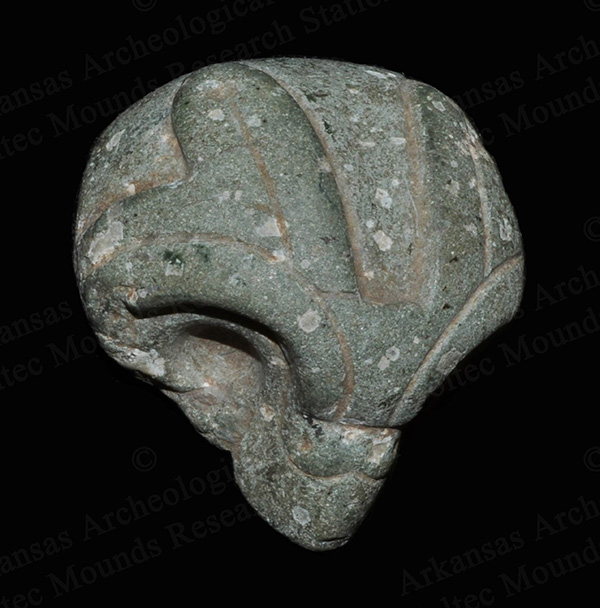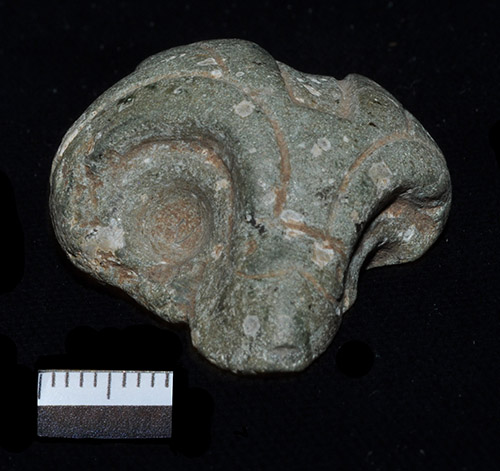On November 2, 2022, the name of Toltec Mounds Archeological State Park was officially changed to Plum Bayou Mounds Archeological State Park and the ARAS research station was renamed the Plum Bayou Research Station. Learn more...
Elizabeth T. Horton
Artifact of the Month - December 2018
One of the more intriguing artifacts recovered from Toltec Mounds is a fragment of a carved stone bird effigy, identified as an owl, measuring only 4 centimeters long. Recovered from the surface of the site after the leveling of Mound G sometime prior to 1955, the effigy is mentioned only briefly by Martha Rolingson (2012:163). While unique for the site as both a carved stone effigy and depiction of an owl, it is not the only bird effigy ever recovered at Toltec Mounds. It is not completely clear why birds, and especially owls, would have been depicted in the art of the Plum Bayou people.

What we do know is that the carving was made from a lithic source, trachyte, that Plum Bayou people used with some regularity for other kinds of stone tools from plummets to pestles. Trachyte—along with some additional lithic sources used by Plum Bayou peoples, such as magnetite, hematite, quartz crystal, and lamprophyres—can be found in some of the geological deposits of the Ouachita Mountains, particularly in the area known today as Magnet Cove. Whether people from Toltec Mounds traveled to the uplands to mine these lithic sources, or traded with villages and hamlets in the area, the Ouachita Mountains source for the raw material of the carved stone fragment indicates it was produced relatively locally, either at Toltec, or at a location that would have been only a few days travel at most.
The carving itself is skillfully and artfully done, with big, round, forward-facing eyes, plumes or “ears” that lay back along the top of the head, and the area above the eyes and along the plumes inscribed with fine lines terminating in small dots. The beak of the bird depicted was probably hooked downward, as owls’ beaks are, but today that portion of the effigy is damaged and missing. These features combined strongly suggest the bird being depicted was an owl. Additionally, plumes along the top of the head indicate that the ancient artist was influenced by one of two different species of owls in the Southeast, the Great Horned Owl or the Eastern screech owl. The fine lines and terminating dots that gracefully highlight the carving are also reminiscent of the artistic style of some decorated ceramics, known as “French Fork Incised,” from Plum Bayou sites.
The production technique used to make the little effigy is called “ground stone.” The artist would have used slightly harder hammerstones to gradually peck and pound away excess material, first roughly shaping the object, then refining it, and carefully adding in the fine lines and terminal dots that accentuate the bird’s face. Eventually the effigy would have been smoothed using a gritty stone like sandstone, until it was perfectly smoothed and shaped. The owl effigy is broken right at the neck of the bird, leaving just the owl’s face. We do not know what it was a part of—a pipe, a carved plummet, an ornament, or a boatstone? All of these Woodland period artifact types have examples with extremely finely executed effigies and carved decorative surfaces.

